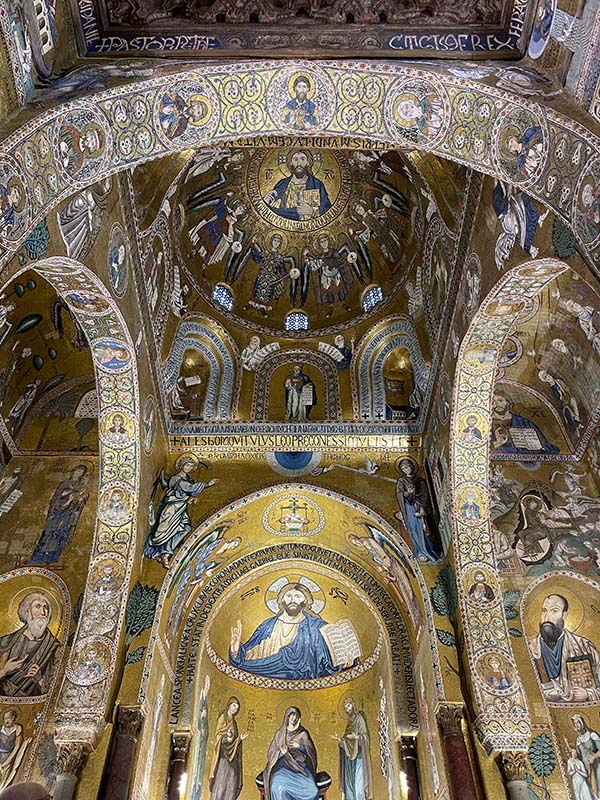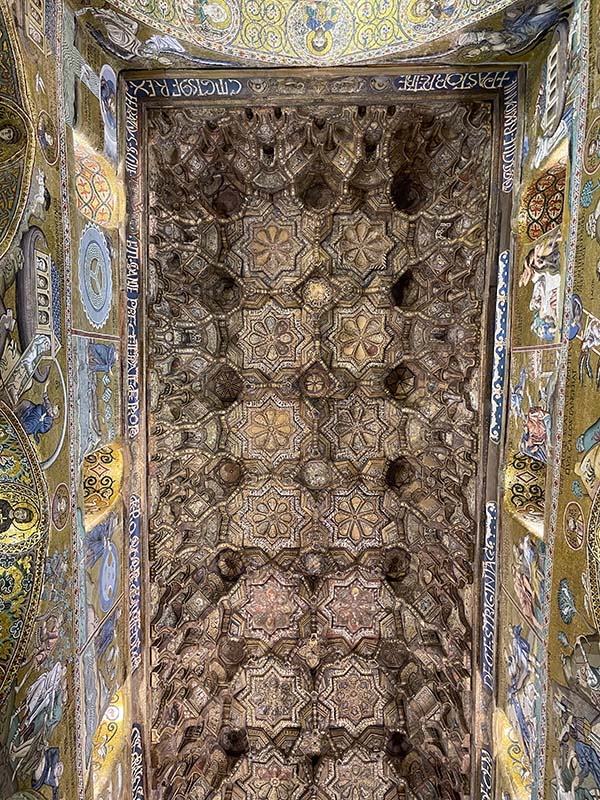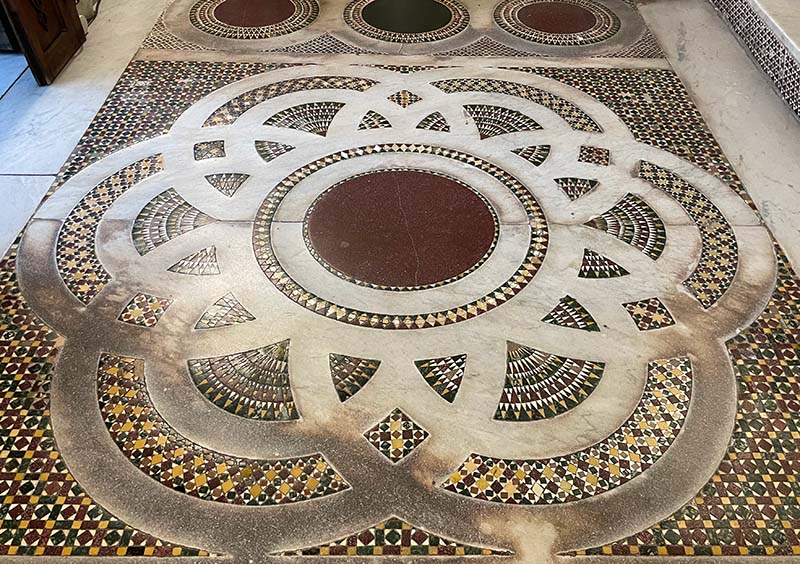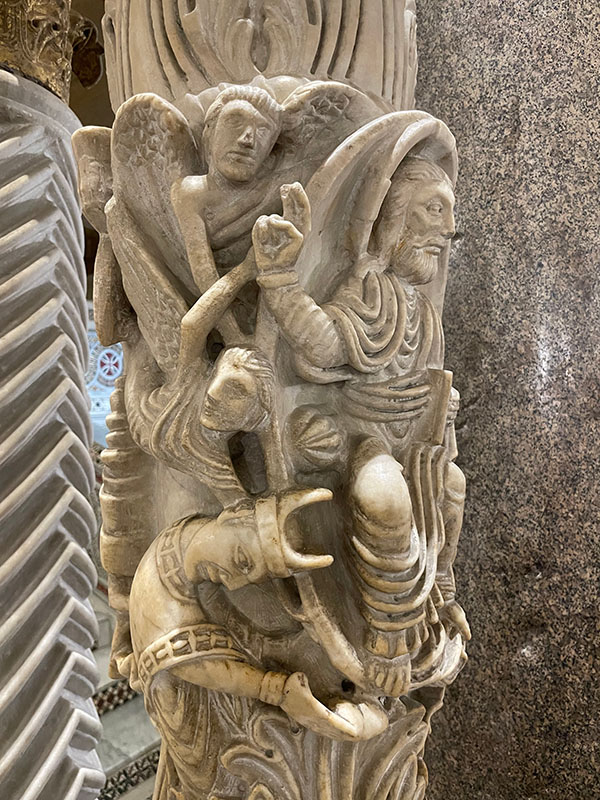Palermo’s Capella Palatina: A Cross-Cultural Jewel Box in Sicily
Click on images to enlarge them and view captions.
by Catherine Carlisle
Perched on the highest point of the ancient center of Palermo, the Palazzo dei Normanni, or Norman Palace, is a rambling assemblage of buildings as old as the city itself. A Phoenician fort enlarged by the Arabs, Norman brothers Roger de Hauteville and Robert Guiscard transformed the fortress into a Royal Palace worthy of their domination of Sicily after thundering into Palermo in 1072. As Decorative Arts Trust members approached this site during our March Study Trip Abroad, we quickly learned that the faded edifice, hemmed in by modern buildings and roadways, belies one of the most unusual, aspirational, and beautiful ornamental expressions held within. The stunning Capella Palatina (or Palace Chapel), the personal chapel of Count Roger de Hauteville’s son King Roger II, is a harmonious and purposeful celebration of disparate cultures, languages, and faiths.
Roger II constructed his Capella Palatina (figure 1) on top of his father’s, turning the earlier chapel into a crypt. This careful placement communicated the chapel as the palace’s symbolic and functional focal point, while also representing Roger II’s glory surpassing that of his father and uncle. He had an insatiable intellectual appetite and was thrilled rather than threatened by scholars in his kingdom and beyond. He welcomed mathematicians, scientists, and philosophers from the European and Arab worlds to his court and was able to converse with them in four languages. Roger II chose an elaborate scheme for the chapel interior that fused Latin, Greek, and Islamic visual traditions, paying homage to each culture while demonstrating his domination over them.
Roger II’s intent is clear from the outset. The plan for the chapel is essentially a combination of traditional Byzantine and Latin designs: on the eastern end is a sanctuary and two side chapels, all ending in apses; on the western end is an enclosed throne platform. Both ends are domed and connected by a long nave flanked by two colonnades delineating side aisles.
Nearly every inch of the walls, arches, ceilings, apses, and dome of the eastern sanctuary is draped with intricate tiled mosaic designs by Byzantine craftsmen. Scenes from the Bible continue along the spandrels of the arches and around the clerestory windows of the nave to the western end of the chapel where they culminate in Christ enthroned between St. Peter and St. Paul, likely added later. Biblical imagery is accompanied by curvilinear Byzantine and geometric Islamic motifs, as well as tiled inscriptions in Arabic, Greek, and Latin.
What makes the chapel visually overwhelming is what fills the space in between: glittering gilt tiles. The impact of light upon the gold creates a shimmering, glowing effect. The orator Philagathos of Cerami described the chapel during its inauguration in 1143: “brilliant with lights, shining with gold, glittering with mosaics, and bright with paintings. He who has seen it many times, marvels when he sees it again, and is as astonished as if he were seeing it for the first time, his gaze wandering everywhere.”1
In the half dome of the central apse, the mosaic of Christ Pantocrator, represented as the ruler of the universe, is the largest mosaic image of a single figure (figure 2). Both Jesus’s hand and the Bible are shown open, indicating a rhetorical or teaching position. This choice was particularly appropriate for Roger II, who prized education and scholars. The dazzling mosaics incorporate an impressive array of multi-cultural symbols, but the technique and tradition itself is thoroughly Byzantine.
As homage to the Arabic Saracen peoples, the most populous group of Roger II’s subjects, the muqarnas ceiling in the nave, executed by North African artisans, is a complex stalactite-like structure made entirely of wooden panels assembled in a repetitive star-and-cross pattern (figure 3). The complicated arrangement is given further dimension by the application of gesso and red, black, white, and blue paint to embellish each minute wooden panel. Roger II is depicted seven times as a seated ruler with his legs crossed, an Islamic portrayal. This exceptional example of Islamic decoration and engineering rivals those of Damascus and Cairo.
The elaborate decoration continues down to the mosaic floor, which is attributed to Salernitano craftsmen. The chapel floor features an exceptional variety of stones, including white marble, green serpentine, and—most significantly—abundant purple porphyry (figure 4). Slabs of the precious stone were brought from Egypt, with the largest piece cut and integrated into the floor in front of the main altar, where Roger II would sit during mass. This placement also put him directly below the glowing Christ Pantocrator. The 15-foot-tall Paschal marble candlestick, located along the south aisle in the nave, is richly carved with figures. Most notably, King Roger II himself is shown wearing a crown and supporting Christ (figure 5).
Roger II’s spectacular—and arguably unrivaled—palace chapel exhibits an extraordinary combination of cultural influences from three great civilizations at a time when such harmonious exchange was truly exceptional. The construction of the chapel brought Byzantine, Italian, and African crafts-people to work alongside each other to create this monument to King Roger II’s new vision for Sicily.
Although Roger II undoubtedly held political motivations in developing his concept for the chapel, he was nevertheless demonstrating a degree of tolerance in Sicily at the same time Christians and Muslims slaughtering each other at the height of the Crusades. Roger II’s intellectualism and receptiveness to other cultures remain a lesson to us all.
- Dirk Booms and Peter Higgs, Sicily: Culture and Conquest (Ithaca: Cornell University Press, 2016), 198.
Catherine Carlisle is the Manager of Educational Programs at the Decorative Arts Trust.
A print version of this article was published in The Magazine of the Decorative Arts Trust, one of our most popular member benefits. Join today!





